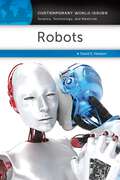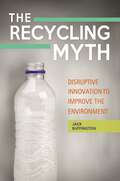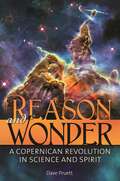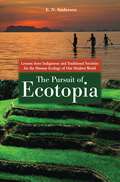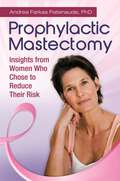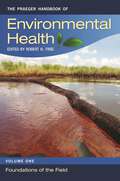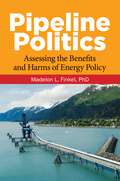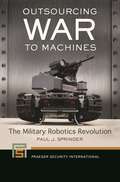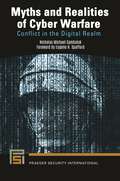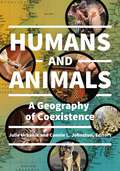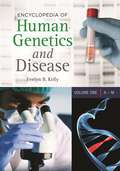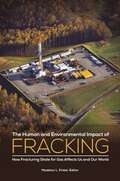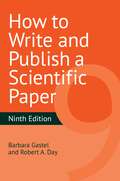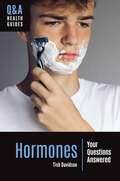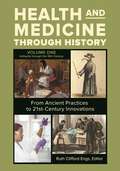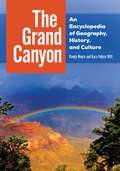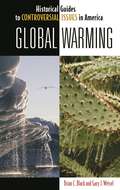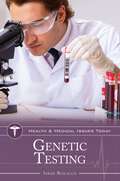- Table View
- List View
Romancing the Atom: Nuclear Infatuation from the Radium Girls to Fukushima
by Robert R. JohnsonThis book presents a compelling account of atomic development over the last century that demonstrates how humans have repeatedly chosen to ignore the associated impacts for the sake of technological, scientific, military, and economic expediency.In 1945, Albert Einstein said, "The release of atomic power has changed everything except our way of thinking … the solution to this problem lies in the heart of mankind." This statement seems more valid today than ever. Romancing the Atom: Nuclear Infatuation from the Radium Girls to Fukushima presents compelling moments that clearly depict the folly and shortsightedness of our "atomic mindset" and shed light upon current issues of nuclear power, waste disposal, and weapons development.The book consists of ten nonfiction historical vignettes, including the women radium dial painters of the 1920s, the expulsion of the Bikini Island residents to create a massive "petri dish" for post-World War II bomb and radiation testing, the government-subsidized uranium rush of the 1950s and its effects on Native American communities, and the secret radioactive material development facilities in residential neighborhoods. In addition, the book includes original interviews of prominent historians, writers, and private citizens involved with these poignant stories.More information is available online at www.romancingtheatom.com.
Robots: A Reference Handbook (Contemporary World Issues)
by David E. NewtonRobots: A Reference Handbook differs from most other books on robotics in the variety of resources that it provides to readers of all ages.Robots: A Reference Handbook teaches readers about a wide variety of robots. It opens with a history of robotics, dating to ancient Greece and Rome, at which time an impressive array of automata were invented for entertainment, religious, and instructional purposes. It follows the development of automata and robots in ancient China and the Islamic world, through to Western Civilization in the present day. Subsequent chapters describe the wide array of applications to which robots are put today and discuss the technical, social, political, ethical, and economic issues created by their increasing use. Additionally, a number of essays by interested individuals highlight various aspects of robotics development. The remaining chapters of the book provide resources that will assist readers in learning more about the topic of robotics.
The Recycling Myth: Disruptive Innovation to Improve the Environment
by Jack BuffingtonThis book states the harsh truth: that despite best intentions, our current environmental practices are doing more harm than good, and that the solution lies in creating supply chains of the future that design, produce, consume, and reuse materials in a manner that is balanced economically and environmentally.One billion beverage containers are used on a daily basis in the United States, with at least 600 million of them ending up in landfills. Even the 400 million that are recycled—at a great cost—are not accomplishing the task of helping the environment. This economic and environmental catastrophe cannot be solved by recycling programs. From his experience as a leader in the American consumer beverage industry and a researcher in Sweden, author Jack Buffington has developed a transformational solution that seeks to not just mitigate the environmental damage but jumpstart the economy while actually achieving zero waste.The Recycling Myth tells the story of how our current environmental practices are unintentionally doing more harm than good and how we need to create a radically different supply chain of the future that must, as best as possible, copy the natural system of growth, decay, and regrowth, and discontinue a disastrous pattern of material design and use. Backed by irrefutable evidence, the book destroys our comfortable notions of the recycling status quo; explains why recycling will never work in the United States, despite decades of attempts; and introduces a new system that will actually work—without asking consumers to consume less.
Reason and Wonder: A Copernican Revolution in Science and Spirit
by Dave PruettIn this enlightening and provocative exploration, Dave Pruett sets out a revolutionary new understanding of our place in the universe, one that reconciles the rational demands of science with the deeper tugs of spirituality.Defining a moment in human self-awareness four centuries in the making, Reason and Wonder: A Copernican Revolution in Science and Spirit offers a way to move beyond the either/or choice of reason versus intuition—a dichotomy that ultimately leaves either the mind or the heart wanting. In doing so, it seeks to resolve an age-old conflict at the root of much human dysfunction, including today's global ecological crisis.An outgrowth of C. David Pruett's breakthrough undergraduate honors course, "From Black Elk to Black Holes: Shaping Myth for a New Millennium," Reason and Wonder embraces the insights of modern science and the wisdom of spiritual traditions to "re-enchant the universe." The new "myth of meaning" unfolds as the story of three successive "Copernican revolutions"—cosmological, biological, and spiritual—offers an expansive view of human potential as revolutionary as the work of Copernicus, Galilleo, and Darwin.
The Pursuit of Ecotopia: Lessons from Indigenous and Traditional Societies for the Human Ecology of Our Modern World
by E. N. AndersonThe world environmental and social justice crises brought on by our high-throughput global economy can be ameliorated only if we adapt the pragmatic ethics of social cohesion in traditional societies to the modern world.Traditional societies have much to teach the modern world about conservation and environmental management. The Pursuit of Ecotopia: Lessons from Indigenous and Traditional Societies for the Human Ecology of Our Modern World argues that the root of our environmental crisis is that we have not devised modern ways to induce people with diverse interests to think and act cooperatively to secure shared interests. We take a short-term, narrow view of resource management and ethical conduct instead of a long-term, global view of "ecotopia"—a conception in which the destructive corollaries of consumerism are curbed by emotionally grounded policies and ethics of sustainability, social justice, and stewardship.In this controversial and brilliantly written book, author E. N. Anderson maintains that the world can escape impending ecological disaster only by embracing a political and ethical transformation that will imbue modern societies with the same shared sense of emotional rationality practiced by traditional cultures. He draws lessons from ecologically successful traditional societies—and also draws cautionary tales from traditional societies that have responded maladaptively to disruption and failed ecologically as a result.
Prophylactic Mastectomy: Insights from Women Who Chose to Reduce Their Risk
by Andrea PatenaudeThis book presents the candid stories of women at high hereditary risk of breast cancer who chose to have their breasts surgically removed while they were still healthy, rather than risk getting the cancer that had, in many cases, devastated others in their family.Author Andrea Farkas Patenaude, a clinical psychologist at the Dana-Farber Cancer Institute, has spent much time talking with women who decided to have risk-reducing or prophylactic mastectomy rather than undergo a lifetime of repeated screenings—a strategy that can help to detect cancers early, but cannot prevent breast cancer. In Prophylactic Mastectomy: Insights from Women Who Chose to Reduce Their Risk, Patenaude shares many candid stories from these women and documents the risks and benefits of this decision.The potential emotional trauma and lifelong effects on self-concept, body image, and sexual function for those who choose the surgery are profound. While the risks involved are great, these interviews also demonstrate the relief many women find in making this powerful decision. This book supplies much-needed guidance for both patients and physicians in confronting this complex decision, and provides comprehensive information on how women fare emotionally and interpersonally after this life-altering surgery.Interviewed as part of a study funded by the Department of Defense Breast Cancer Research Program and the National Human Genome Research Institute, the subjects are diverse: married and single women, young adults, the middle-aged, parents, and women without children. Every case reveals the ramifications of each individual's difficult but potentially life-saving decision. The women explain why they made their choice, how they adapted to the new look of their bodies, and how they cope with spouses', partners', and family members' reactions to their changed physique.
The Praeger Handbook of Environmental Health [4 volumes]: [4 volumes]
by Robert H. FriisWritten by internationally acclaimed experts in the United States and abroad, this comprehensive set of environmental health articles serves to clarify our impending challenges as well as opportunities for health and wellness.Written in an accessible style that is appropriate for general readers as well as professionals in the environmental health field, this work provides a comprehensive yet coherent review of the principal environmental challenges that confront our society. This four-volume work taps a multidisciplinary team of experts from across the nation to present emerging information about how our world is being impacted, the effects on health and life, and the steps we are taking—and should take—to correct or avoid the problems. The Praeger Handbook of Environmental Health comprises four volumes: Foundations of the Field; Agents of Disease; Water, Air, and Solid Waste; and Current Issues and Emerging Debates. Within each volume, chapters cover the latest scientific research findings in an objective manner and present practical applications of the information. Topics addressed include air and water contaminants, PCBs, hazardous waste, household cleaning products, dioxin, plastics, radiation, radon, electromagnetic fields, and noise and light pollution, just to name a few. This title stands alone in its comprehensive coverage of environmental health topics.
Pipeline Politics: Assessing the Benefits and Harms of Energy Policy
by Madelon L. FinkelAn essential review of the history, benefits, limitations, failures, and politics of pipelines, with a core focus on potential harms to environmental and human health.The United States holds the world record of having the largest network of energy pipelines, with more than 2.4 million miles of pipeline transporting oil or natural gas. Russia, China, and Canada as well as many other countries also have extensive pipelines. How safe is this means of transport, and is there a potential harm to the environment and human health? In this text, professor Madelon L. Finkel presents an essential and clearly-stated review of the pros and cons of transporting oil and natural gas by pipeline. Finkel dispels myths, inaccuracies, and misconceptions and highlights the potential dangers that must be considered in any country's energy policy.Pipeline Politics: Assessing the Benefits and Harms of Energy Policy provides a broad and accessible analysis of pipelines, from their history and safety to their politics and risks. Finkel examines the benefits and costs of pipelines in parallel as well as issues of environmental justice; the fairness of treatment of the people affected; and the development, implementation, and enforcement of pipeline laws, regulations, and policies.
Outsourcing War to Machines: The Military Robotics Revolution (Praeger Security International)
by Paul J. SpringerMilitary robots are affecting both the decision to go to war and the means by which wars are conducted. This book covers the history of military robotics, analyzes their current employment, and examines the ramifications of their future utilization.Robotic systems are the future of military conflicts: their development is already revolutionizing the nature of human conflict—and eroding the standards of acceptable behavior in wartime. Written by a professor who teaches strategy and leadership for the U.S. Air Force, one of the global leaders in the development and utilization of military robots, this book both addresses the history of military robotics and discusses the troubling future ramifications of this game-changing technology.Organized both chronologically and thematically, the book's chapters describe the development and evolution of unmanned warfare; clarify the past, current, and future capabilities of military robotics; and offer a detailed and convincing argument that limits should be placed upon their development before it is too late. This standout work presents an eye-opening analysis that military personnel, civil servants, and academic instructors who teach military history, social policy, and ethics can ill afford to ignore, and will also provide the general public with information that will correct misconceptions about military robotics derived through popular culture and the news media.
Oil [2 volumes]: A Cultural and Geographic Encyclopedia of Black Gold [2 volumes]
by Dr Brian C. Black Dr Michelle Brym Christopher Cumo Li Fang Susan Henke Max Homerding Dr Douglas Hurt Dr Katrina Lacher Matthew Jon Leeper Jr. Dr Xiaobing Li Michael Molina Adam Payne Li Weiying Gregory Stephen Whitaker Dr Zhang XiaoyiDespite ongoing efforts to find alternatives, oil is still one of the most critical—and valuable—commodities on earth. This two-volume set provides extensive background information on key topics relating to oil, profiles countries that are major producers and consumers of oil, and examines relevant political issues.Aside from air and water, oil is perhaps the most valuable natural resource. Oil supplies the tremendous energy needs of the modern world. What exactly is "oil," where does it come from, how does it get consumed, and who is using it? This encyclopedia provides clear answers to these questions and more, offering students entries on the fundamentals of the oil industry and profiles of the countries that play a major role in oil production and consumption.Volume 1 presents topical entries on critical concepts, key terms, major oil spills and disasters, and important organizations and individuals relating to the oil industry. Entries define terms such as "barrel" and "reserve," cover incidents such as the BP oil spill, and explain the significance of organizations such as OPEC. The second volume spotlights specific countries that are major producers, consumers, exporters, and importers of oil, from the United States to Russia to Saudi Arabia to Venezuela. Each profile shows readers the importance of oil in that country through a brief background history, data on its oil usage or production, information about major trading partners, and an explanation of political issues.
Numbers: A Cultural History
by Robert KielyNumbers: A Cultural History provides students with a compelling interdisciplinary view of the development of mathematics and its relationship to world cultures over 4,500 years of human history.Mathematics is often referred to as a "universal language," and that is a fitting description. Many cultures have contributed to mathematics in fascinating ways, but despite its "universal" character, mathematics is also a human endeavor. It has played pivotal roles in societies at particular times; and it has influenced, and been influenced by, a wide range of ideas and institutions, from commerce to philosophy. Ancient Egyptian views of mathematics, for example, are tied closely to engineering and agriculture. Some European Renaissance views, on the other hand, relate the study of number to that of the natural world.Numbers, A Cultural History seeks to place the history of mathematics into a broad cultural context. While it treats mathematical material in detail, it also relates that material to other subject matter: science, philosophy, navigation, commerce, religion, art, and architecture. It examines how mathematical thinking grows in specific cultural settings and how it has shaped those settings in turn. It also explores the movement of ideas between cultures and the evolution of modern mathematics and the quantitative, data-driven world in which we live.
Nuclear Power: A Reference Handbook (Contemporary World Issues)
by Harry HendersonProvides timely and up-to-date facts, context, perspectives, and tools to make informed decisions about nuclear energy.In the 21st century, nuclear power has been identified as a viable alternative to traditional energy sources to stem global climate change, and condemned as risky to human health and environmentally irresponsible. Do the advantages of nuclear energy outweigh the risks, especially in light of the meltdown at the Fukushima plant in 2011? This guide provides both a comprehensive overview of this critical and controversial technology, presenting reference tools that include important facts and statistics, biographical profiles, a chronology, and a glossary. It covers major controversies and proposed solutions in detail and contains contributions by experts and important stakeholders that provide invaluable perspective on the topic.
NextGen Genealogy: The DNA Connection
by David R. Ph.D.DNA testing can serve as a powerful tool that unlocks the hidden information within our bodies for family history research. This book explains how genetic genealogy works and answers the questions of genealogists and individuals seeking information on their family trees.Now that DNA testing for genealogical purposes has existed for nearly a decade and a half—and been refined and improved during that time—it has established its value among family history researchers. It is now becoming accepted as another tool in the kit of well-rounded genealogists. This book covers this fast-growing application of genetics, empowering genealogists to apply this information to further their research. It will also enable general readers to understand how genetic information can be applied to verify or refute documentary research—and to break down frustrating walls that block the discovery of ancestors.The book describes the three major categories of DNA testing for family history research: Y-chromosome tests for investigating paternal (surname) lines, mitochondrial tests for investigating maternal (umbilical) lines, and autosomal tests for exploring close relationships. Expert genealogist David Dowell provides guidance on deciding which test to take and identifying which members of your family should be tested to answer your most important genealogical questions. Readers will also learn how to interpret the results of tests and methods for further analysis to get additional value from them.
Myths and Realities of Cyber Warfare: Conflict in the Digital Realm (Praeger Security International)
by Nicholas Michael SambalukThis illuminating book examines and refines the commonplace "wisdom" about cyber conflict—its effects, character, and implications for national and individual security in the 21st century."Cyber warfare" evokes different images to different people. This book deals with the technological aspects denoted by "cyber" and also with the information operations connected to social media's role in digital struggle.The author discusses numerous mythologies about cyber warfare, including its presumptively instantaneous speed, that it makes distance and location irrelevant, and that victims of cyber attacks deserve blame for not defending adequately against attacks. The author outlines why several widespread beliefs about cyber weapons need modification and suggests more nuanced and contextualized conclusions about how cyber domain hostility impacts conflict in the modern world.After distinguishing between the nature of warfare and the character of wars, chapters will probe the widespread assumptions about cyber weapons themselves. The second half of the book explores the role of social media and the consequences of the digital realm being a battlespace in 21st-century conflicts. The book also considers how trends in computing and cyber conflict impact security affairs as well as the practicality of people's relationships with institutions and trends, ranging from democracy to the Internet of Things.
Humans and Animals: A Geography of Coexistence
by Julie Urbanik and Connie L. Johnston, EditorsAn engaging and at times sobering look at the coexistence of humans and animals in the 21st century and how their sometimes disparate needs affect environments, politics, economies, and culture worldwide.There is an urgent need to understand human-animal interactions and relations as we become increasingly aware of our devastating impact on the natural resources needed for the survival of all animal species. This timely reference explores such topics as climate change and biodiversity, the impact of animal domestication and industrial farming on local and global ecosystems, and the impact of human consumption of wild species for food, entertainment, medicine, and social status. This volume also explores the role of pets in our lives, advocacy movements on behalf of animals, and the role of animals in art and media culture. Authors Julie Urbanik and Connie L. Johnston introduce the concept of animal geography, present different aspects of human-animal relationships worldwide, and highlight the importance of examining these interconnections. Alphabetical entries illustrate key relationships, concepts, practices, and animal species. The book concludes with a comprehensive appendix of select excerpts from key primary source documents relating to animals and a glossary.
Encyclopedia of Human Genetics and Disease [2 volumes]: [2 volumes]
by Evelyn B. KellyThis two-volume encyclopedia examines the history, characteristics, causes, and treatment of genetic disease, as well as the science of genetics itself.Modern science has unlocked many of the mysteries of genetics, providing a blueprint for understanding the origins behind previously mysterious ailments and conditions, both common and uncommon. A complete understanding remains elusive, however: geneticists are still refining theories about what causes chromosomes to mutate, and genetic diseases remain difficult to diagnose and challenging to treat. This fascinating reference explores the scientific and human aspects of this complex field of science.Encyclopedia of Human Genetics and Disease features nearly 400 entries, including well-known genetic diseases, rare and lesser-known genetic diseases, and the genetic factors that may contribute to common diseases and health conditions, such as breast cancer and obesity. The author presents in-depth discussions of concepts essential to understanding genetic disease in 18 entries that provide background on key topics, such as "Genetics 101," the genome and the foundations of genetics, genetic counseling, and newborn screening. Each of the 355 disorders profiled provides the history of the condition, its prevalence, causes, treatment (if any), and further reading. Interesting sidebars and compelling photos that help inform content accompany many entries.
The Human and Environmental Impact of Fracking: How Fracturing Shale for Gas Affects Us and Our World (Public Health Issues and Developments)
by Madelon L. FinkelFracking for gas trapped in shale could be a game changer in the quest to find alternatives to dirty fossil fuels, but it also has potential for harm. This book provides "one-stop shopping" for everyone who wants to know more about the issues.Oil and gas account for a large percentage of the world's energy consumption, and the search for new ways to extract both from the earth is a global quest. Fracking is viewed as an energy game-changer but is a controversial topic about which there is much misunderstanding. This unbiased work was written to bring clarity to the issues. Under the guidance of an internationally recognized public health expert, this book provides a comprehensive look at unconventional natural gas development from many different perspectives.Written for the layperson, the book dispels myths surrounding fracking, corrects misconceptions, and offers impartial, scientifically based information on both benefits and challenges. Readers will learn about the effects fracking has on the environment—our water, air, and climate—as well as on human and animal health. The contributors also look at the economics of fracking and at its socioeconomic impact on local communities and nations. They discuss legal and ethical issues related to the practice and, in keeping with the intent to provide a fair and balanced overview, share the industry perspective as well.
How to Write and Publish a Scientific Paper
by Barbara Gastel Robert A. DayThoroughly updated throughout, this classic, practical text on how to write and publish a scientific paper takes its own advice to be "as clear and simple as possible.""The purpose of scientific writing," according to Barbara Gastel and Robert A. Day, "is to communicate new scientific findings. Science is simply too important to be communicated in anything other than words of certain meaning."This clear, beautifully written, and often funny text is a must-have for anyone who needs to communicate scientific information, whether they're writing for a professor, other scientists, or the general public. The thoughtfully revised 9th edition retains the most important material-including preparing text and graphics, publishing papers and other types of writing, and plenty of information on writing style-while adding up-to-date advice on copyright, presenting online, identifying authors, creating visual abstracts, and writing in English as a non-native language.A set of valuable appendixes provide ready reference, including words and expressions to avoid, SI prefixes, a list of helpful websites, and a glossary. Students and working scientists will want to keep How to Write and Publish a Scientific Paper at their desks and refer to it at every stage of writing and publication.
Hormones: Your Questions Answered (Q&A Health Guides)
by Tish DavidsonThis book provides easy-to-understand, scientifically backed answers to readers' questions about hormones, helping them understand the many important roles they play, particularly during adolescence.Especially during the teenage years, people are quick to blame raging hormones for everything from acne to rebellious behavior. But hormones play vital and varied roles throughout our lives, driving such basic processes as growth and metabolism and orchestrating sexual maturation and reproduction. But for many, hormones are mysterious and misunderstood. How much do you really know about hormones, how they affect our health, and how what we do can affect them?Books in Greenwood's Q&A Health Guides series follow a reader-friendly question-and-answer format that anticipates readers' needs and concerns. Prevalent myths and misconceptions are identified and dispelled, and a collection of case studies illustrate key concepts and issues through relatable stories and insightful recommendations. Each book also includes a section on health literacy, equipping teens and young adults with practical tools and strategies for finding, evaluating, and using credible sources of health information both on and off the internet—important skills that contribute to a lifetime of healthy decision making.
Health and Medicine through History [3 volumes]: From Ancient Practices to 21st-Century Innovations [3 volumes]
by Ruth Clifford EngsThis three-volume set provides a comprehensive yet concise global exploration of health and medicine from ancient times to the present day, helping readers to trace the development of concepts and practices around the world.From archaeological evidence of trepanning during prehistoric times to medieval Europe's conception of the four humors to present-day epidemics of diabetes and heart disease, health concerns and medical practices have changed considerably throughout the centuries. Health and Medicine through History: From Ancient Practices to 21st-Century Innovations is broken down into four distinct time periods: antiquity through the Middle Ages, the 15th through 18th centuries, the 19th century, and the 20th century and beyond. Each of these sections features the same 13-chapter structure, touching on a diverse array of topics such as women's health, medical institutions, common diseases, and representations of sickness and healing in the arts. Coverage is global, with the histories of the Americas, Europe, Asia, Africa, and Oceania compared and contrasted throughout. The book also features a large collection of primary sources, including document excerpts and statistical data. These resources offer readers valuable insights and foster analytical and critical thinking skills.
Groundbreaking Scientific Experiments, Inventions, and Discoveries of the Middle Ages and the Renaissance (Groundbreaking Scientific Experiments, Inventions and Discoveries through the Ages)
by Robert E. KrebsThe Middle Ages and the Renaissance were a period of scientific and literary reawakening. Scientific development and a renewed interest in classical science led to new discoveries, inventions, and technologies. Between 500 and 1600 A.D., scientific explorers rediscovered ancient Greek and Eastern knowledge, which led to an eruption of fresh ideas. This reference work describes more than 75 experiments, inventions, and discoveries of the period, as well as the scientists, physicians, and scholars responsible for them. Individuals such as Leonardo da Vinci, Marco Polo, and Galileo are included, along with entries on reconstructive surgery, Stonehenge, eyeglasses, the microscope, and the discovery of smallpox.Part of a unique series that ranges from ancient times to the 20th century, this exploration of scientific advancements during the Middle Ages and the Renaissance will be useful to high school and college students, teachers, and general readers seeking information about significant advances in scientific history.
The Grand Canyon: An Encyclopedia of Geography, History, and Culture
by Randy Moore Kara Felicia WittThis single-volume encyclopedia examines the Grand Canyon in depth, from the native peoples who have survived there for centuries to the explorers who charted its vast expanses and to the challenges that Grand Canyon National Park faces.The Grand Canyon is one of the most internationally recognized landscapes and symbols of nature in North America. In this one-volume encyclopedia, readers can dive into the many people, places, stories, and issues associated with the Grand Canyon as well as the scientific, religious, and social contexts of events that have made the Grand Canyon what it is. At the front of the encyclopedia are thematic essays that examine the Grand Canyon's history, geography, and culture. Essays cover topics including John Wesley Powell, to whom the Grand Canyon "belongs," the Native Americans who live at the Grand Canyon, and the future of the Grand Canyon. Following the thematic essays are approximately 150 topical entries focusing on more specific aspects of the Grand Canyon, such as trails and camps, natural formations, and courageous heroes as well as shameless profiteers who have influenced the Grand Canyon's history. The encyclopedia is rounded out by a chronology of human history at the Grand Canyon, a Grand Canyon "at a glance" section, and multiple fact-based sidebars. Through the people, places, and stories explored in this work, readers will gain a better understanding of how the history of the Grand Canyon is relevant to the world today.
Global Warming (Historical Guides to Controversial Issues in America)
by Brian C. Black Gary J. WeiselTracing scientific ideas about the structure of Earth, Global Warming creates an intellectual portrait of the shifts in thinking that have led to the current controversy, enabling readers to make up their own minds on this important issue.Global Warming takes one of the hot-button issues of our time and surveys it in historical context, creating an intellectual portrait of the multi-century shifts in thinking that have led to gradual acceptance of the concept. The book summarizes pertinent aspects of geology, earth science, and climate science in easy-to-read terms. It then frames this background in terms of cultural and social shifts, including the Industrial Revolution, conspicuous consumption, and modern environmentalism. In addition, a study of the ebb and flow of cultural and political reception relates the issue to religious and social ideas.The information presented here will enable the reader to understand the scientific case stating that human activity has caused an unprecedented warming in the late 20th and early 21st centuries. Technical and political objections to this thesis are also covered, so that readers may form their own opinions on this critical subject.
Ghost Guns: Hobbyists, Hackers, and the Homemade Weapons Revolution
by Mark A. TallmanWith thorough analysis and balanced reporting, Ghost Guns: Hobbyists, Hackers, and the Homemade Weapons Revolution is an essential resource for readers seeking to understand the rise of homemade firearms and future options for managing them.For more than a century, strict gun control was possible because firearms were produced in centralized industrial factories. Today, the Fourth Industrial Revolution, combining old and new technologies, threatens to upend this arrangement. An increasing number of hobbyists, "makers," technology provocateurs, and sophisticated criminals are proving that you don't need a factory to make guns anymore. The security challenges of this transformation are increasingly apparent, but the technologies behind it hold tremendous potential, and while ignoring the security implications would entail risks, the costs of new policies also must be evaluated. "Do-it-yourself," or DIY, weapons will bring significant ramifications for First and Second Amendment law, international and homeland security, crime control, technology, privacy, innovation, and the character of open source culture itself. How can a liberal society adjust to technologies that make it easier to produce weapons and contraband? Informative and thought-provoking, Ghost Guns: Hobbyists, Hackers, and the Homemade Weapons Revolution carefully analyzes the technical, legal, social, political, and criminological trends behind this challenging new area of illicit weapons activity.
Genetic Testing (Health and Medical Issues Today)
by Sarah BoslaughGenetic testing has provided important clues to understanding our health, but it has also raised many ethical, legal, and medical questions and concerns. This book explores the breadth of genetic testing, its possibilities, and the controversies that surround its use.The mapping of the human genome has paved the way for a variety of genetic tests. Expectant mothers can have their fetus screened for a variety of genetic abnormalities, and couples worried that they might be carriers for a genetic disorder can be tested before deciding to have children. Women can be screened for the BRCA2 gene that has been linked to increased risk of breast cancer. Individuals curious about their ancestry can find out more about their heritage. Genetic testing can also be used to establish paternity and help solve crimes.Part of Greenwood's Health and Medical Issues Today series, this book is divided into three sections. Part I explores the history of genetic testing, including the rise of direct-to-consumer tests, and outlines the current applications and contexts in which genetic testing is performed. Part II delves deep into the ethical, legal, financial, medical, and psychological issues and controversies that surround genetic testing. Part III provides a variety of useful materials, including case studies, a timeline of critical events, and a directory of resources.

